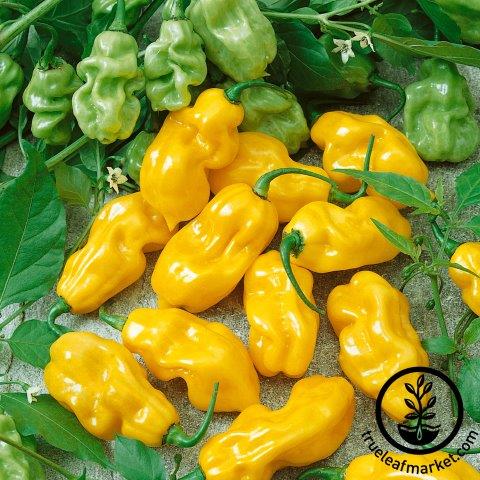
Ashleigh Smith

Peppers are one of the most popular summer vegetables to grow. They love the warm summer months and make the perfect summer snack, fresh salsa ingredient, pizza topping, or splash of color in your fajitas. Peppers are definitely one of my must have garden vegetables. Not only are they colorful, but they come in a variety of flavors and heat levels. Below you can find recommendations from each level of spiciness to suite your fancy. Hotter peppers will have more capcaisin, the natural spice compound, in them. The scoville scale heat units can be used as a guide to just how spicy the peppers in each category will be.
What is the Scoville Scale?
The scoville scale is named after its creator Pharmacist Wilbur Scoville who started measuring the spice level of hot chilis using a organoleptic (taste test) in 1912. This test was most popularly used until it was replaced by the High-Performance Liquid Chromatography (HPLC) test in 2011. This test measures the capsaicinoid content in an analytic quantification rather than a subjective human assessment.
Types of Peppers
Ornamental
Ornamental Peppers are grown for their appearance, rather than taste. While they are primarily used for their looks, they may still be used in culinary applications. As for their spice levels, it depends on the individual varieties which appear across the scoville scale.

Sweet (0-100 SHU)
Include peppers without heat, such as the bell, banana, mini sweet, and long sweet peppers. These are ideally used for snacking, salsa, cooking, roasting, and grilling. While they don’t have any heat, they do add a fresh flavor to your favorite dishes.
Hot (100+ SHU)
Hot peppers have a spicy sensation that accompanies their unique flavor profiles. The level of spice in pepper is dependent on the amount of capsaicin (a natural chemical compound triggering spiciness. The hotter the pepper, the greater the concentration. For reference, standard U.S. grade pepper spray registers at a Scoville heat unit up to 5,300,000, and Pure capsaicin measures up to 16,000,000 SHU. The hottest known pepper is the Carolina Reaper measuring up to 2,200,000 SHU. Whether you want the essence of spice or your tongue to feel like it is going to walk away on its own, there is a pepper for you.

Mild (100-2,500): Include Pepperoncini, Anaheim, and Poblano peppers.
Medium (2,500-30,000): Include Jalapenos, Hungarian, and Serrano types.
Hot (30,000-100,000): Include Cayenne, Tabasco, and Thai peppers.
Extra Hot (100,000-300,000): Include most Habaneros, Scotch bonnets, and Fatali’s.
Extremely Hot (300,000-1,000,000+): Includes Ghost Peppers, Red Savina, Chocolate Habanero, Trinidad Scorpion, and the Carolina Reaper. These will for sure knock your socks off and have you sweating.
About the Author

I'm Ashleigh Smith, a native to Northern Utah. I first gained a love of gardening with my grandmother as I helped her each summer. I decided to make a career of it and have recently graduated with a Bachelor's degree in Horticulture from Brigham Young University - Idaho. My studies have focused on plant production while I also have experience in Nursery & Garden Center Operations.
Our Recommended Picks
Leave a comment
Your email address will not be published. Required fields are marked *
1 comments
Anne Guarnieri
Hi, Looking for an Italian long pepper -can you direct me?
Further Reading

How to Start a Garden Journal: What to Track and Why It Matters
Written By Lara Wadsworth What was the best tomato variety you grew last year? When was the last time you fertilized your roses? How long has it been since you pruned your apple tree? What was that new variety of carrot you heard about last fall? If yo...

Ashleigh Smith
2025-05-206 min read0
Neem Oil for Gardens: What It Is & How to Use It
Written By Lara Wadsworth As more gardeners turn to natural and organic gardening solutions, it's no surprise that neem oil has become the go-to solution for pest and disease control. This centuries-old plant-based remedy has long been used to fend off...

Ashleigh Smith
2025-05-199 min read0
Microgreens Activities for Kids: Easy Gardening Fun at Home
Written By Lara Wadsworth Getting kids involved in gardening and food production is a wonderful way to create lasting bonds and educate them about food and nutrition. Microgreens are a super-easy way to do this! You can grow them right in your home and...

Ashleigh Smith
2025-05-147 min read0
Easy Tomato Pruning Tips Every Home Gardener Should Know
Written By Ashleigh Smith Tomatoes are one of the most popular plants in the home vegetable garden. They are tasty and boast a variety of uses from pasts, sauces, salsas, and so much more! Boost your tomato yields by properly pruning your plants for gr...

Ashleigh Smith
2025-05-136 min read6































